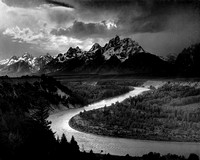Revealed: Ansel AdamsAnsel Adams is one of the undisputed masters of landscape photography. His works are influential to this day, and this post aims at showing why he remains extremely relevant, while amusingly informing discussions that go on in the digital world, despite the fact he passed away in 1984.
Do keep in mind Adams lived from 1902 till 1984, being most active between the 30s and 60s. If at first glance your reaction is along the lines of "ok, this is very traditional work", realize that our notion of what a traditional landscape photography looks like owes an immense lot to Adams' work. From here on, it would be easy to continue lauding his photographs and to simply comment some of his breathtaking works, but it seems more interesting to focus on what makes his black and white photography so interesting, and how that can inform modern debates in photography. In large part, it is the stark contrasts between very dark and very light - and the exquisite use of the range in between - that make his pictures so magnificent and fascinating. How did he achieve this? Obviously, deep knowledge of photography technique lead him to excellent exposure. Proper set-up and use of his camera were critical, as was identifying the right moment and light to take his photographs. But a key element in Adams' work was his darkroom technique. He used dodging and burning extensively and masterfully, and that is very interesting for contemporary discussion of the place of post-processing in digital photography. It has become commonplace to criticize "photoshopping", by which people mean changing a photograph from what was actually taken by the camera, as if photography was all about the capture and ended at the moment the photographer releases the shutter button. It's common to have a non-photographer ask you whether you modified the picture after you took it and seem disappointed when you say you did. Even seasoned photographers are sometimes heard professing that a "good" photographer gets his exposure in camera and doesn't tinker with it afterwards. Remembering that a classic film photographer like Adams worked extensively in the darkroom to lighten and darken specific areas of his photographs to produce the photograph he had visualized in his mind when taking it is thus crucial. What he showed wasn't the "pure" photograph taken by his camera, but a conjunction of what his camera had captured and his work on this material to achieve the picture he initially desired. We are not talking about correcting a mistake here (although that might of course happen too), but about artistic expression and creating the intended work of art. Burning and dodging were very complex and required expertise in the film world : dodging meant physically blocking out an area of the enlarger lens to avoid light hitting the paper, whereas burning required masking out all the picture except for the area to be burned to increase the light on the paper. On the other hand, in the digital world a few clicks are enough to dodge and burn. But these differences are irrelevant. Work done in Photoshop, Lightroom, or any other comparable software package aims at the exact same thing as Adams' complex darkroom work: obtaining the desired tones, irrespective of what "came out of the camera". In other words, photography is all about the relationship between the subject, the photographer and the viewer. The camera and whatever other tools might be involved are only there to facilitate this triangular relationship. That might be one of the most important lessons Adams provided us; the aim of photography is that the final work looks the way you intended it to. All the rest - and singularly how you obtained your end result - is a means to an end, and utterly unimportant. While techniques might be interesting to practitioners, they are totally irrelevant when evaluating the artistic merit of the works. So the next time somebody starts telling you that so and so's work is "too processed", remember Ansel Adams and ask the only question that matters: "ok, but does it have artistic merit in your eyes?".
Keywords:
Ansel Adams,
revealed
Comments
No comments posted.
Loading...
|

